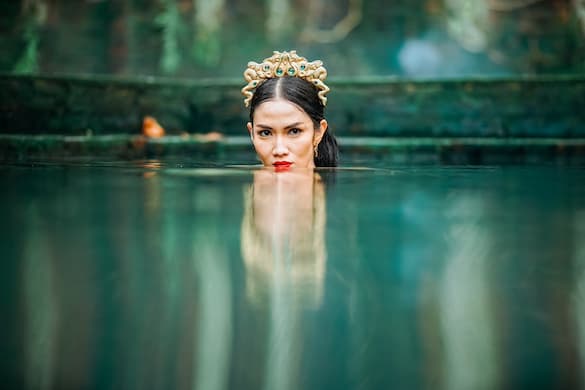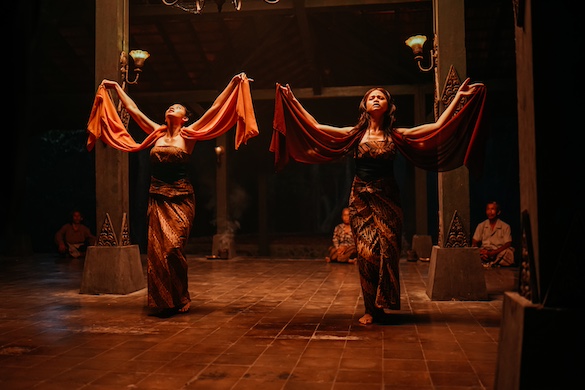‘Exoticism’ Is No Dirty Word When Describing ‘Dancing Village: The Curse Begins,’ a Gem From Indonesia
Best of all is Alia Sarah, who swivels her way through the scenery as Badarawuhi, an entity who is as sexual as she is unholy. She makes the Wicked Witch of the West look like Winnie the Pooh.

What do you think gets a worse rap movie-wise: sequels or prequels? The former have been with us for more than a century. The first picture to garner a sequel, or, if you prefer, a knock-off, was D.W. Griffith’s “The Birth of a Nation” (1915). In order to cash in on Griffith’s notorious milestone, a novelist, minister, lawyer, and “professional racist,” Thomas Dixon, helmed “The Fall of a Nation” (1916). Given Dixon’s bonafides, should we be grateful the film has been lost? Oddly, the lone thing about it that does survive is the score.
Although prequels can also be traced to the silent era — most historians cite “The Golem: How He Came Into the World” (1920) as the first — the phenomenon has become predominant in recent years. The name recognition of certain properties, along with audience bases whose devotion to them seemingly knows no bounds, all but guarantees advantageous box office receipts. How good these ventures are is another matter.
A question common to sequels and prequels is how they should be experienced: as a chapter in a series without which it is rendered confusing, or as individual efforts that hold up on their own terms? When notice for “Dancing Village: The Curse Begins” came into my mailbox, I was seduced by its over-the-top trailer and then chagrined to read that the film is a prequel to “KKN di Desa Penari” (2022). How much of the new film can be understood without having seen, let alone been aware of, the original?
“KKN di Desa Penari” was based on a Twitter thread that was later published as a novel, both being the creation of a person working under the moniker SimpleMan. The story was subsequently adapted for the screen by Lele Maila and Gerald Mamahit, and then placed in the hands of director Awi Suryadi. Upon release, “KKNA de Desa Penari” became the highest-grossing film in its country of origin, Indonesia. The producer, Manoj Punjabi, has the Midas touch: MD Pictures has had no shortage of blockbuster hits.

How will “Dancing Village: The Curse Begins” play to audiences outside of Indonesia? Although “exotic” is a dirty word in progressive circles, as well as something that has presumably become outmoded in our globalist age, a primary draw for Western audiences will likely be just how foreign the picture is — not just in terms of language, but of landscape, architecture, customs, decor, fashion, narrative conventions, and myth. Exoticism isn’t inherently demeaning; it can also connote genuine curiosity and be a spur for outreach and esteem.
Having said that, you don’t have to be Joseph Campbell or, amongst his acolytes, George Lucas to intuit how universal stories can be. Notwithstanding the particularity of its flourishes, “Dancing Village: The Curse Begins” is a resolutely mainstream, even conventional entertainment. A bunch of young adults — children, really — go on a journey to a faraway place in order to do right by their elders and, fingers crossed, themselves. Along the way they encounter an abundance of ill tidings and a village ruled by a mythical being who possesses not an ounce of good will. A magical bracelet is involved. So, too, is a pool filled with snakes.
There’s hocus-pocus galore to be had here. Director Kimo Stamboel offsets so-so practical effects through spooky transitions of dialogue and character and, for the movie’s finale, channels Busby Berkeley. Cinematographer Patrick Tashadian keys the entirety of the picture to a burnished palette of tawny browns and verdant greens. And while one could wish that Fachrun Daud had been more economical in editing, his skills do make for moments that are as unsettling as they want to be.
Best of all is Alia Sarah, who swivels her way through the scenery as Badarawuhi, an entity who is as sexual as she is unholy. And, boy, does the actress go to town with her performance: Ms. Sarah makes the Wicked Witch of the West look like Winnie the Pooh. Her initiative, along with Mr. Tashadian’s sonorities, are what you’ll recall five years down the line.
As for prequels, sequels, and the like: “Dancing Village: The Curse Begins” is sensational enough in its (admittedly loose) contours to render the question moot.

